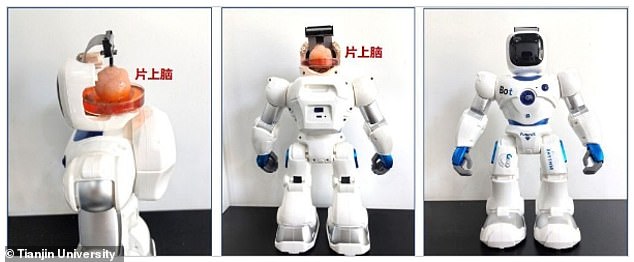Chinese Scientists Create Frankenstein Robot With A HUMAN BRAIN

Chinese scientists have created a Frankenstein-like robot controlled by a tiny human brain, a first.
The robot works using a lab-grown brain organoid, a mass of cells and a computer chip that communicates with the brain’s nervous system.
It is described as a ‘brain on a chip’ that functions like a human brain using sensors and an AI-driven algorithm that makes the robot move, grab objects and avoid obstacles.
The team claimed that the brain shows signs of intelligence similar to the human brain, by moving its extremities autonomously. This could lead to methods of repairing damage to the human cerebral cortex and other techniques for curing neurological disorders.

A team of Chinese scientists used stem cells to build the brain and linked it to a computer chip that transmits instructions to the robot’s body, helping it move its limbs, avoid obstacles and track targets
A team of Chinese scientists used stem cells – a type of cell that forms brain tissue in the body – to build the brain.
They connected it to a computer chip that transmits instructions to the robot’s body. This chip consists of a mix of human cells and computer chips that function like a human brain.
Scientists from Tianjin University designed the machine using brain-computer interfaces (BCI) that combine the electrical signals emitted by the brain with the computer chips.
This interface is the same system that Elon Musk used to create his Neuralink chip, which is implanted into the brain of a human patient, allowing him to control a computer with his thoughts.
The Neuralink device is controlled by a special chip in the implant, which processes signals and sends them to a computer via a standard Bluetooth connection.
However, the Chinese researchers have not disclosed how they transmit the signals to their organoid.
To create their “living machine,” the team used pluripotent stem cells — a type of cell that exists in early embryonic development — to form the organoids, which divided into different types of cells found in the brain, including tissue, said Ming Dong, the study’s lead author.
Organoids are small, self-organized three-dimensional tissue cultures made from stem cells.
Such cultures can be engineered to mimic much of the complexity of an organ, or to express certain aspects of it, such as producing only certain types of cells.
Scientists take the stem cells and culture them for about a month, until they form features that resemble neurons.
However, the Chinese scientists have not disclosed how they trained the organoid to know when the robot should perform specific tasks.
According to the team, the technology still faces “bottlenecks such as low development rate and insufficient nutrient supply,” which typically includes antioxidants, fiber and minerals.
When the organoids were transplanted into the brain, a functional connection was formed when treated with low-intensity ultrasound.
Low-intensity ultrasound stimulation regrows human tissue, creating neurons that send signals from the brain, allowing the robot to move autonomously.
Researchers explained that the robot has no eyes and only responds through the electrical and sensory signals sent by its neurons.
The team clarified that the pink spot on top of the robot’s shoulders in the images is only a cosmetic representation of what the brain will look like, and not the actual tissue still being used in prototypes.
“Brain organoid transplants are considered a promising strategy for restoring brain function by replacing lost neurons and reconstructing neural circuits,” the study said, according to the South China Morning Post.
However, the research is still in its early stages and it is unclear whether the organoids can ever be used to repair or reconstruct damaged brain tissue.

Experts have made special perforations in the face of a robot, allowing a layer of skin to attach
This came days after scientists in Japan transplanted human skin tissue and skin ligament structures onto the face of a robot to display human emotions.
Scientists from the University of Tokyo have published a report video featuring a bizarre, smiling robot face made from lab-grown human skin.
According to the team, robots with real skin not only look “increasingly realistic,” but can also heal themselves if damaged.




